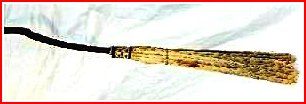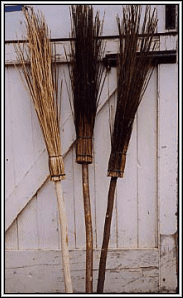Fascinating History of Brooms



Most homes in ancient Europe had dirt floors and the only way to keep a home clean was to sweep it out. That was done with a broom simply made of straw, herbs or twigs tied to a handle. Early brooms were called a besom and usually caused more of a mess than they were worth. Traditionally a round besom handle was made of hazel or ash wood and represented a tree branch. Scholars believe the broom was associated with the Tree of Life, an important pagan symbol in ancient Europe.
Before 1797, brooms in America were handmade from tree branches and brush. These crude brooms didn’t work well and fell apart quickly. The quality of brooms changed in 1797 when Levi Dickenson, a Massachusetts farmer, made a broom for his wife using tassels from a variety of sorghum. She thought Levi’s broom was, by comparison, an exceptional improvement.
Word spread quickly and Levi was soon swamped with orders. However, these brooms also had a tendency to fall apart, as was the nature of brooms at the time. Although they were an improvement Levi was not satisfied. In 1810 he invented the foot-treadle broom machine. Not long afterwards, flat brooms, made of broom corn were made by the Shakers,an industrious religious order.


By 1830, about 60,000 brooms were being produced annually. This was more than enough for Americans so the nation went into the broom export business. Some sources say there were about 305 broom factories by the late 1830s in America and by 1920 over 1,000, mostly in eastern states. By the time the Great Depression hit, the number of factories had tapered off back to around 320. Because broom corn grew exceptionally well in Oklahoma it became a major broom production center.
However, brooms have had a fascinating history other than their usefulness of being a cleaning implement. During World War II, American submarines would hoist a broomstick when pulling into port, indicating they had "swept" the seas clear of enemy vessels.
Brooms have also long been associated with witchcraft in Western cultures. Halloween is a good example where we see witches clad in black, with pointed hats flying around on medieval style round brooms. It was in 1453, the self proclaimed warlock Guillaume Edelin confessed to what became the first known case of flying broomsticks…predating the Wright brothers by centuries.
However, there had been folklore about witches flying on sticks or similar objects. But these reports differed slightly by descriptions about some kind of magical ointment first being applied to the broomstick. Some witch folklore indicates magic wands were often disguised as broomsticks and sometimes temporarily harbored particular spirits. Today the broom is included in many pagan manuals as a ritual tool called a besom. They are sometimes laid at coven entrances. It represents the element of air and is used in purifying ritual areas of negative energy instead of incense, since some are allergic to it.
Some African American wedding ceremonies also incorporate its use in a custom called jumping the broom. During America’s slave era some slaves were not allowed to have a church wedding. Jumping over the broomstick represented jumping into a new life as a married couple. Today besom style brooms are still crafted and sold at garden centers. Some are finely decorated and may also be scented.
Early Celtic pagans associated the broom with fairies and forest sprites. Some legends tell about witches asking fairies to lead them to a perfect tree to get a broom staff for a broom. The fairies would then endow it with magical powers. A few ancient brooms have been found with hidden compartments in the handle. The compartments were used to store herbs, oils, feathers and other ritualistic items needed to cast spells.
Today, old style brooms are still made by craftsmen for fun and profit. And perhaps, witches still fly on them because frankly, they’d look ridiculous on a Hoover.





